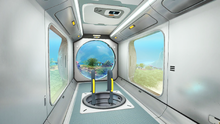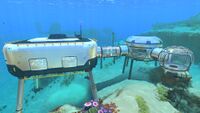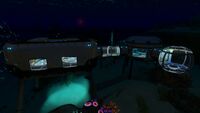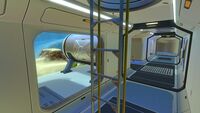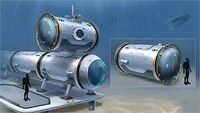Seabases (Subnautica): Difference between revisions
m (→Energy) |
No edit summary |
||
| Line 18: | Line 18: | ||
[[File:Seabase interior.png|thumb|220x220px]] |
[[File:Seabase interior.png|thumb|220x220px]] |
||
[[Hull Integrity]] refers to the ability of the player's Seabase to withstand the pressure of the surrounding water. The majority of the modules lower the hull integrity. At |
[[Hull Integrity]] refers to the ability of the player's Seabase to withstand the pressure of the surrounding water. The majority of the modules lower the hull integrity. At greater depth the integrity reduction caused by each module increases. |
||
When the hull integrity of a Seabase is less than or equal to zero, it will begin to form hull breaches. Any corridor or room that is connected to the breach will begin flooding with water. Bulkheads can compartmentalize the base and prevent floodwaters from moving between compartments, but if the integrity remains below zero then eventually every compartment will develop a leak and the base will fill completely with water. To avoid this, quickly increase the base's integrity (by either adding strengthening components or removing weak components) and fix all hull breaches in the base using a [[Repair Tool]]. |
When the hull integrity of a Seabase is less than or equal to zero, it will begin to form hull breaches. Any corridor or room that is connected to the breach will begin flooding with water. Bulkheads can compartmentalize the base and prevent floodwaters from moving between compartments, but if the integrity remains below zero then eventually every compartment will develop a leak and the base will fill completely with water. To avoid this, quickly increase the base's integrity (by either adding strengthening components or removing weak components) and fix all hull breaches in the base using a [[Repair Tool]]. |
||
| Line 24: | Line 24: | ||
Seabase modules use a multiplier system on negative hull integrity penalties instead of having a specific crush depth, and are not affected by high local temperatures. |
Seabase modules use a multiplier system on negative hull integrity penalties instead of having a specific crush depth, and are not affected by high local temperatures. |
||
A Seabase that receives damage to its exterior (or even a knife hit from inside) will also spring leaks, but the hull integrity will be unaffected. For the most part only the player can damage a Seabase, typically through vehicle collisions: otherwise aggressive [[Fauna]] will ignore one, though predators may be seen trying to attack prey species through the walls of a module containing an [[Alien Containment]] tank. Exceptions to this are [[Crashfish]] placed in an Alien Containment which can damage the base when they explode, and [[Tiger Plant]]s placed in either Alien Containment or an [[Exterior Growbed]], which can damage the base with missed shots. |
A Seabase that receives damage to its exterior (or even a knife hit from inside) will also spring leaks, but the hull integrity will be unaffected. For the most part, only the player can damage a Seabase, typically through vehicle collisions: otherwise, aggressive [[Fauna]] will ignore one, though predators may be seen trying to attack prey species through the walls of a module containing an [[Alien Containment]] tank. Exceptions to this are [[Crashfish]] placed in an Alien Containment which can damage the base when they explode, and [[Tiger Plant]]s placed in either Alien Containment or an [[Exterior Growbed]], which can damage the base with missed shots. |
||
Seabase modules built above water do not use the hull integrity system. If a base is partially above water, the components that are above will neither add to or subtract from the hull |
Seabase modules built above water do not use the hull integrity system. If a base is partially above water, the components that are above will neither add to or subtract from the hull integrity of the base overall. |
||
== Energy == |
== Energy == |
||
[[Energy]] is a resource that needs to be managed for bases, much |
[[Energy]] is a resource that needs to be managed for bases, much like Food, Water and Oxygen need to be for the player. Each Seabase has its own energy storage capacity, and bases handle their energy demands and generation individually. |
||
=== Energy Production === |
=== Energy Production === |
||
Energy is produced by energy generators, all buildable by the player through the use of the [[Habitat Builder]]. There are four different types, two can only be built inside a [[Multipurpose Room]], and the other two must be placed externally. These last two can be located further away from the habitable parts of the seabase if the |
Energy is produced by energy generators, all buildable by the player through the use of the [[Habitat Builder]]. There are four different types, two can only be built inside a [[Multipurpose Room]], and the other two must be placed externally. These last two can be located further away from the habitable parts of the seabase if the player rigs up [[Power Transmitter]]s to bridge the gap. |
||
Each energy generator comes with its own '''energy storage capacity''' and its own '''energy generation rate.''' |
Each energy generator comes with its own '''energy storage capacity''' and its own '''energy generation rate.''' |
||
| Line 41: | Line 41: | ||
Built on their own: |
Built on their own: |
||
* [[Solar Panel]]s (capacity 75E, rate varies) convert light to energy during daylight hours at a variable rate affected by depth |
* [[Solar Panel]]s (capacity 75E, the rate varies) convert light to energy during daylight hours at a variable rate affected by depth |
||
* [[Thermal Plant]]s (capacity 250E, rate varies) convert heat energy (build near [[Lava Geyser]]s and Black Smokers) at a variable rate affected by local water temperature |
* [[Thermal Plant]]s (capacity 250E, the rate varies) convert heat energy (build near [[Lava Geyser]]s and Black Smokers) at a variable rate affected by local water temperature |
||
=== Energy Usage === |
=== Energy Usage === |
||
| Line 176: | Line 176: | ||
|- |
|- |
||
| style="text-align:center; font-size:12px;" |[[File:Observatory.png|70px|center|link=Observatory]][[Observatory]] |
| style="text-align:center; font-size:12px;" |[[File:Observatory.png|70px|center|link=Observatory]][[Observatory]] |
||
| style="text-align:left; font-size:12px;" |Compartment with 360 |
| style="text-align:left; font-size:12px;" |Compartment with 360-degree views and low structural integrity. |
||
| style="text-align:center;" | -3.0 Units |
| style="text-align:center;" | -3.0 Units |
||
|- |
|- |
||
Revision as of 15:13, 20 November 2019
Seabases are installations created by the player through the use of the Habitat Builder.
A Seabase provides an area where the Player can return for oxygen, and serves as an alternative to Lifepod 5 as a base of operations. Within a seabase, the player can construct additional storage space, grow food, access Appliances not available in Lifepod 5, and add aesthetic options. Thus Seabases provide safe havens away from the Safe Shallows the player starts in.
In all Game Modes except Creative Mode, entering a Seabase secures the player's inventory, so if the player dies, they will return to the last Seabase' they visited and keep all the items in their inventory that they had when they were there (unless they later enter a Cyclops or Lifepod 5).
The player will start out with most of the blueprints they need for a basic Seabase; at bare minimum one needs a Compartment, a Hatch, and a power generator (the Solar Panel is unlocked by default). The initial compartment must be built on or near the ground (or on a Foundation, which is not necessary but provides greater hull integrity and a flat surface to work with), but any additional compartments can overhang without any issue, allowing bases to be built over cliffsides. The player can expand once they've gathered more Blueprints.
|
Spoiler alert: The following section contains story related material. |
|---|
|
Degasi Seabases can be found at the center and on the tops of the mountains of the Floating Island, Jellyshroom Cave, and Deep Grand Reef. These abandoned Seabases provide blueprints for additional base components that the player doesn't have access to by default, such as the Multipurpose Room and the Observatory. Other base components, power generators, appliances and furniture, can be found in Wrecks. |
Despite their name, Seabases can be built on land. When on land, Hull Integrity is not a factor, and can be built without the need of additional Reinforcements, Foundations, or Bulkheads. Power is still needed for them to operate, however.
Hull Integrity
Hull Integrity refers to the ability of the player's Seabase to withstand the pressure of the surrounding water. The majority of the modules lower the hull integrity. At greater depth the integrity reduction caused by each module increases.
When the hull integrity of a Seabase is less than or equal to zero, it will begin to form hull breaches. Any corridor or room that is connected to the breach will begin flooding with water. Bulkheads can compartmentalize the base and prevent floodwaters from moving between compartments, but if the integrity remains below zero then eventually every compartment will develop a leak and the base will fill completely with water. To avoid this, quickly increase the base's integrity (by either adding strengthening components or removing weak components) and fix all hull breaches in the base using a Repair Tool.
Seabase modules use a multiplier system on negative hull integrity penalties instead of having a specific crush depth, and are not affected by high local temperatures.
A Seabase that receives damage to its exterior (or even a knife hit from inside) will also spring leaks, but the hull integrity will be unaffected. For the most part, only the player can damage a Seabase, typically through vehicle collisions: otherwise, aggressive Fauna will ignore one, though predators may be seen trying to attack prey species through the walls of a module containing an Alien Containment tank. Exceptions to this are Crashfish placed in an Alien Containment which can damage the base when they explode, and Tiger Plants placed in either Alien Containment or an Exterior Growbed, which can damage the base with missed shots.
Seabase modules built above water do not use the hull integrity system. If a base is partially above water, the components that are above will neither add to or subtract from the hull integrity of the base overall.
Energy
Energy is a resource that needs to be managed for bases, much like Food, Water and Oxygen need to be for the player. Each Seabase has its own energy storage capacity, and bases handle their energy demands and generation individually.
Energy Production
Energy is produced by energy generators, all buildable by the player through the use of the Habitat Builder. There are four different types, two can only be built inside a Multipurpose Room, and the other two must be placed externally. These last two can be located further away from the habitable parts of the seabase if the player rigs up Power Transmitters to bridge the gap.
Each energy generator comes with its own energy storage capacity and its own energy generation rate.
Built inside a Multipurpose Room:
- Bioreactors (capacity 500E, rate 50E/min) convert organic matter into a certain amount of energy at a set rate
- Nuclear Reactors (capacity 2500E, rate 250E/min) convert Reactor Rods into a certain amount of energy at a set rate
Built on their own:
- Solar Panels (capacity 75E, the rate varies) convert light to energy during daylight hours at a variable rate affected by depth
- Thermal Plants (capacity 250E, the rate varies) convert heat energy (build near Lava Geysers and Black Smokers) at a variable rate affected by local water temperature
Energy Usage
Each appliance consumes a certain amount of energy for a task and it does this at a certain energy consumption rate. The energy requirement may be either continuous or only when a device is being used, depending on the type of device: for example, a Fabricator only uses energy while it is creating something, while a Floodlight uses energy constantly.
If energy is not being used, Bioreactors and Nuclear Reactors will not consume resources.
The following Appliances draw power from the Seabase:
- Fabricator
- Battery Charger
- Power Cell Charger
- Modification Station
- Water Filtration Machine
- Spotlight
- Floodlight
- Moonpool
- Vehicle Upgrade Console (fabricator only)
- Scanner Room (fabricator and active scanning, along with recharging the Camera Drones)
Seabases do not require energy to operate in Creative Mode. A notable exception to this is the ability to dock a Seamoth in a Moonpool, which does require power.
Energy transfer
Power Transmitters are used to transfer energy. They come with some caveats. Most obviously, they can only transmit power from a generator to a base, not from a base to a distant power-demanding structure.
Oxygen
Seabases automatically produce Oxygen as long as there is power supplied. If the power is depleted, the Seabase will slowly lose oxygen, until it is completely gone.
Oxygen is always available in any portion of a seabase that is above water, regardless of power.
How to Build a Seabase
- Find a suitable piece of land.
- Equip the Habitat Builder and press RMB (Xbox One:
 , PlayStation 4:
, PlayStation 4: ) to bring up a crafting menu.
) to bring up a crafting menu. - In the Habitat Compartments tab, select the desired module.
- Aim at the desired building place (the outline of the module will become green if the location is valid).
- Adjust the rotation with Mousewheel Up and Mousewheel Down or [ and ] (Xbox One and PlayStation 4:Error: Invalid Button SpecifiedError: Invalid Button Specified).
- Place the module with LMB (Xbox One:
 , PlayStation 4:Error: Invalid Button Specified).
, PlayStation 4:Error: Invalid Button Specified). - Once placed, hold LMB (Xbox One:
 , PlayStation 4:Error: Invalid Button Specified) to add the required materials to finish the building process.
, PlayStation 4:Error: Invalid Button Specified) to add the required materials to finish the building process. - Go to Step 2 and repeat for each room you want to build.
To deconstruct a Seabase module, equip the Habitat Builder and hold Q (Xbox One and PlayStation 4:Error: Invalid Button Specified) while facing the module. If enough inventory space is available, the module will be deconstructed and all materials used to create the module will be returned to the player's inventory, one item at a time. Note that everything inside the module and attached to the outside of the module must be deconstructed before the module itself can be deconstructed.
Audio
The Seabase's AI plays various messages that correspond to different circumstances, some accompanied by sound cues:
| Trigger | Dialogue | |
|---|---|---|
| When Seabase is repaired | "Hull integrity restored. Draining systems initiated." | |
| When Seabase or Cyclops has no power | "Warning: Emergency power only. Oxygen production offline." | |
| Restoring Seabase's power | "Power restored. All primary systems online." | |
| Entering Seabase, Seamoth or Prawn Suit | "Welcome aboard captain." |
Available Modules
| Modules | Description | Hull Integrity |
|---|---|---|
| Alien Containment | Provides optimal conditions for flora and fauna. Add a hatch to enter. | 0 Units |
| Bulkhead | Provides structural support and prevents flooding. | +3.0 Units |
| Basic Compartment | Basic tubular compartment. | -1.0 Unit |
| Glass Compartment | Basic glass-walled compartment. | -2.0 Units |
| L Compartment | L-shaped compartment. | -1.0 Unit |
| L Glass Compartment | L-shaped glass compartment. | -2.0 Units |
| T Compartment | T-shaped compartment. | -1.0 Unit |
| X Compartment | X-shaped compartment. | -1.0 Unit |
| Foundation | Reinforced habitat foundation. | +2.0 Units |
| Hatch | Provides an access point to the habitat. | -1.0 Unit |
| Ladder | Connects two floors. | 0 Units |
| Wall Planter | Wall-mounted foliage. Purely decorational. | 0 Units |
| Moonpool | Vehicle docking bay. | -5.0 Units |
| Multipurpose Room | Basic room. | -1.25 Units |
| Observatory | Compartment with 360-degree views and low structural integrity. | -3.0 Units |
| Reinforcement | Increases hull strength. | +7.0 Units |
| Scanner Room | Locates resources and wrecks within range. | -1 Units |
| Spotlight | Fixed lighting solution. | 0 Units |
| Vehicle Upgrade Console | Build in the Moonpool to upgrade docked vehicles. | 0 Units |
| Vertical Connector | Vertical base connector. | -0.5 Units |
| Water Filtration Machine | Turns seawater into water and salt. | -2.0 Units |
| Window | Observatory window. | -1.0 Unit |
- Note that negative changes to hull integrity increase with depth. For more information see Hull Integrity.
Gallery
<tabber> Screenshots=
An example of a Seabase, including a Multipurpose Room, Moonpool and an Observatory
A Seabase on the Floating Island
|-| Concept Art=
Seabase Concept art
Seabase Interior Concept art
</tabber> Lua error in package.lua at line 80: module 'Dev:Navbox' not found.


